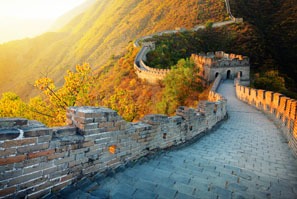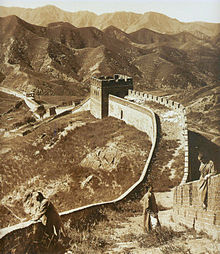 GREAT WALL OF CHINA
GREAT WALL OF CHINA
The great wall: is widely recognized as one of the most
incredible architectural accomplishments in history.It was
designed specifically as a defense to protect the Chinese empire
from the invaders.
most of the great wall we see today was built in the Ming
dynasty.the great wall was designated a UNESCO world
heritage site in 1987.
Why You Should Visit The Great Wall
"Greatest Human Feat in History": The Great Wall is the building project with the longest duration and greatest cost in human lives, blood, sweat and tears. It deserves its place among "the New Seven Wonders of the World" and the UNESCO World Heritage Sites.
3 important facts about the Great Wall of China:
1.
The Great Wall is
not a continuous line:
there are side walls, circular walls, parallel walls, and sections with no wall
(high mountains or rivers form a barrier instead). In the Qin Dynasty (221–206
BC), glutinous rice
flour was used to bind the Great Wall bricks.
2. The Wall you know and love is not as old as you think:
The Wall is widely thought to date back 2,000 years to just after 221 BC,
when China was first unified. In fact, almost everything which is that old is
no more than a mound of earth. The popular idea of the Wall derives from the
stone, battlement structure built by the Ming (1358–1644). Its maximum age is
about 500 years.
3. The Chinese don’t call the Wall ‘the Great Wall’:-The Chinese term for the Wall emerges from a distant past – long before
“the Great Wall” was used – when every city had its own wall.
So fundamental was the connection between walls and cities that the Chinese
used one word to cover them both, and they still do. There it is, in the Oxford
Union Press’s standard concise dictionary: Chéng: “1. city;
2. City wall”. The Wall, of course, is rather more than a city wall, so
Chinese adds an adjective, not “great” but “long”. So the Chinese for “the
Great Wall”, cháng chéng, means Long City. And Long Wall. And Long
Cities, or Long Walls, plural. There is a way to resolve the contradiction:
peel back a city wall in your mind, stretch it out, put farms and garrisons
along it, and there you have it – Great Wall(s) equals Long City/ies.
Who Built the Great Wall and Why:
The "Long Wall" has a long history — more than 2,300 years. It was built in different areas by different states/dynasties to protect different territorial borders.
Why was the Great Wall of China built?
The primary purpose was always to protect the Chinese Empire from the Mongolians and other invaders. Most of the current Great Wall we see today was built
in the Ming Dynasty (1368-1644) and is approximately 6000km long. 2.
... The Mongols were a tribal group that would regularly conduct raids
into China.
The Great Wall's Structure — Walls, Watchtowers, Fortresses…
The Great Wall was not just a wall. It was an integrated military defensive system with watchtowers for surveillance, fortresses for command posts and logistics, beacon towers for communications, etc.
In the Ming Dynasty (1368–1644), the Great Wall was reconstructed to
be stronger and more sophisticated, due to better construction
techniques being developed.
- The wall body: The Ming Great Wall usually had battlements 1.8 meters (6 feet) high with loopholes and crenels, and parapet walls 1.2 meters (4 feet) high.
- Flanking towers: Every 500 meters or less (1,640 feet) on the Great Wall there was a flanking tower allowing defenders to shoot arrows at attackers at the face of the wall.
The Great Wall easily required the greatest human effort of any ancient construction! 100 million tonnes of bricks, stone, and soil were transported and assembled by millions of soldiers, peasants, prisoners, and animals using basic rope, wood, and basket systems on remote terrain ranging from parched desert to steep mountain ridges.

thank you friends hope it helped you about the article of great wall of china.



